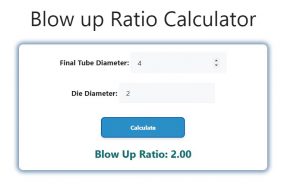About Blow up Ratio Calculator (Formula)
The Blow Up Ratio (BUR) is an essential measurement in the manufacturing of tubular products, particularly in the plastics and rubber industries. It quantifies how much a material expands when it is extruded through a die, helping manufacturers ensure consistency and quality in their products. Understanding and accurately calculating the BUR can lead to more efficient production processes and improved product performance.
Formula
The formula for calculating the Blow Up Ratio (BUR) is:
BUR = Final Tube Diameter / Die Diameter
Where:
- Final Tube Diameter is the diameter of the tube after extrusion.
- Die Diameter is the diameter of the die used during the extrusion process.
How to Use
To use the Blow Up Ratio calculator:
- Input the Final Tube Diameter: Enter the diameter of the tube after it has been extruded.
- Input the Die Diameter: Enter the diameter of the die used in the extrusion process.
- Click Calculate: Press the “Calculate” button to obtain the Blow Up Ratio.
- Review the Result: The calculated BUR will be displayed in the designated result field.
Example
Suppose you have a final tube diameter of 4 inches and a die diameter of 2 inches. To calculate the BUR, you would input these values into the calculator:
- Final Tube Diameter: 4 inches
- Die Diameter: 2 inches
Using the formula:
BUR = 4 / 2 = 2.00
Thus, the Blow Up Ratio would be 2.00, indicating that the tube has expanded to twice its original die diameter.

FAQs
- What is Blow Up Ratio?
- The Blow Up Ratio (BUR) measures the expansion of a tube during the extrusion process.
- Why is BUR important?
- BUR is crucial for ensuring product consistency and quality in manufacturing processes.
- How is BUR calculated?
- BUR is calculated by dividing the final tube diameter by the die diameter.
- What units are used in BUR calculations?
- BUR is typically expressed as a ratio and can use any linear measurement units (inches, millimeters, etc.).
- What factors can affect the Blow Up Ratio?
- Factors include material properties, extrusion speed, and die design.
- Can BUR exceed a certain value?
- Yes, but excessively high BUR values may lead to defects in the product.
- Is there an optimal BUR range for different materials?
- Yes, optimal BUR ranges vary by material type and application, often determined through testing.
- How does temperature affect BUR?
- Higher temperatures can affect material flow and expansion, influencing the BUR.
- What is a common application of BUR?
- BUR is commonly used in the production of plastic tubes and films.
- Can BUR be used to compare different extrusion processes?
- Yes, comparing BUR values can help assess the efficiency and effectiveness of different processes.
- What is the typical BUR for polyethylene?
- The typical BUR for polyethylene can range from 1.5 to 3.0, depending on the specific process.
- How can manufacturers improve BUR?
- Improvements can be made by optimizing die design, material selection, and processing conditions.
- What happens if the BUR is too low?
- A low BUR may indicate under-extrusion, leading to weaker products.
- Are there software tools for calculating BUR?
- Yes, many manufacturing software solutions include BUR calculations as part of their features.
- Can BUR calculations help with troubleshooting?
- Yes, analyzing BUR can assist in identifying issues within the extrusion process.
- What is the relationship between BUR and wall thickness?
- Changes in BUR can affect the wall thickness of the extruded product, impacting its strength.
- How frequently should BUR be monitored?
- BUR should be regularly monitored, especially when changing materials or processes.
- Is BUR calculation necessary for all extruded products?
- While important for most, the necessity of BUR calculation may vary based on product requirements.
- Can BUR impact the recyclability of materials?
- Yes, BUR can influence the properties of materials, affecting their recyclability.
- What is the impact of die design on BUR?
- Die design significantly affects BUR, influencing how material expands during the extrusion process.
Conclusion
The Blow Up Ratio (BUR) is a critical parameter in the manufacturing of tubular products, providing insights into material behavior during the extrusion process. By using the provided calculator and understanding the factors influencing BUR, manufacturers can optimize their processes, enhance product quality, and ensure operational efficiency. Regularly monitoring and analyzing BUR is essential for achieving consistent results and maintaining high manufacturing standards.